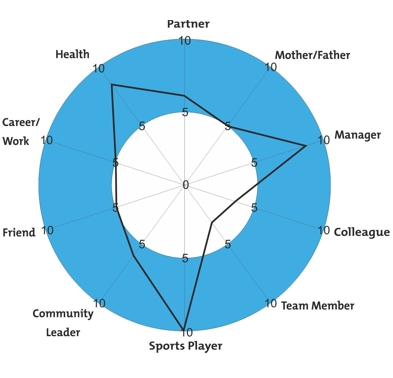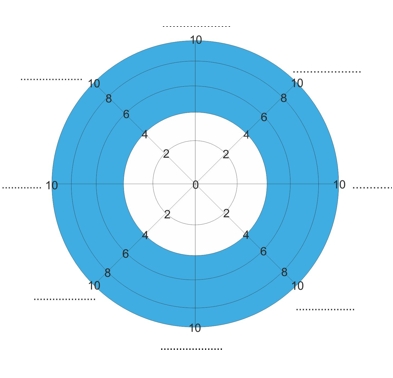Finding Balance in Your Life
"Wheel of Life" is a trademark of Meyer Resource Group, Inc. "Success Motivation" is a trademark of Success Motivation, Inc. (see www.success-motivation.com). We have no association or connection with these organizations.

Put your life under the microscope.
© iStockphoto/Snowleopard1
When life is busy, or all your energy is focused on a special project, it's all too easy to find yourself off balance, not paying enough attention to important areas of your life. While you need to have drive and focus if you're going to get things done, taking this too far can lead to frustration and intense stress.
That's when it's time to take a "helicopter view" of your life, so that you can bring things back into balance.
This is where the Wheel of Life® (or Life Wheel) can help. Commonly used by professional life coaches, it helps you consider each area of your life in turn and assess what's off balance. As such, it helps you identify areas that need more attention.
Figure 1 below shows an example wheel of life with example "dimensions" (we'll explain how to choose the right areas of life or dimensions for you below).
Figure 1 – Wheel of Life Example

The Wheel of Life is powerful because it gives you a vivid visual representation of the way your life is currently, compared with the way you'd ideally like it to be. It is called the "Wheel of Life" because each area of your life is mapped on a circle, like the spoke of a wheel. The concept was originally created by Paul J. Meyer, founder of Success Motivation® Institute, Inc.
Using the Tool
There are two ways you can use this tool. One is to use our interactive tool below (click on the diagram to activate it).
Alternatively, use the following steps to create your Life Wheel by hand and assess your balance. (This allows you to define your own dimensions.)
Start by downloading our free worksheet which contains a blank Wheel of Life diagram as shown in figure 2, below.
Figure 2 – Wheel of Life Template

1. Brainstorm Life Areas
Start by brainstorming the six to eight dimensions of your life that are important for you. Different approaches to this are:
- The roles you play in life, for example: husband/wife, father/mother, manager, colleague, team member, sports player, community leader, or friend.
- Areas of life that are important to you, for example: artistic expression, positive attitude, career, education, family, friends, financial freedom, physical challenge, pleasure, or public service.
- Your own combination of these (or different) things, reflecting the things that are your priorities in life.
2. Write These Down on the Wheel
Write down these dimensions on the diagram, one on each spoke of the life wheel.
3. Assess Each Area
This approach assumes that you will be happy and fulfilled if you can find the right balance of attention for each of these dimensions. And different areas of your life will need different levels of attention at different times. So the next step is to assess the amount of attention you're currently devoting to each area.
Consider each dimension in turn, and on a scale of 0 (low) – to 10 (high), write down the amount of attention you're devoting to that area of your life. Mark each score on the appropriate spoke of your Life Wheel.
4. Join Up the Marks
Now join up the marks around the circle. Does your life wheel look and feel balanced?
5. Think About Your Ideal Level
Next it's time to consider your ideal level in each area of your life. A balanced life does not mean getting 5 in each life area: some areas need more attention and focus than others at any time. And inevitably you will need to make choices and compromises, as your time and energy are not in unlimited supply!
So the question is, what would the ideal level of attention be for you in each life area?
Plot the "ideal" scores around your life wheel too.
6. Take Action
Now you have a visual representation of your current life balance and your ideal life balance. What are the gaps? These are the areas of your life that need attention.
And remember that gaps can go both ways. There are almost certainly areas that are not getting as much attention as you'd like. However there may also be areas where you're putting in more effort than you'd ideally like. These areas are sapping energy and enthusiasm that may better be directed elsewhere.
Once you have identified the areas that need attention, it's time to plan the actions needed to work on regaining balance. Starting with the neglected areas, what things do you need to start doing to regain balance? In the areas that currently sap your energy and time, what can you stop doing or reprioritize or delegate to someone else? Make a commitment to these actions by writing them on your worksheet.
Tip:
You can use the Wheel of Life as preparation for goal setting or coaching. It helps identify the areas you want to work on and is a great way of visualizing your current and desired life. Once you are working on improving your life balance, it's also a useful tool for monitoring your life balance as it changes over time.
Key Points
The Wheel of Life is a great tool to help you improve your life balance. It helps you quickly and graphically identify the areas in your life to which you want to devote more energy, and helps you understand where you might want to cut back.
The challenge now is to transform this knowledge and desire for a more balanced life into a positive program of action.
No comments:
Post a Comment